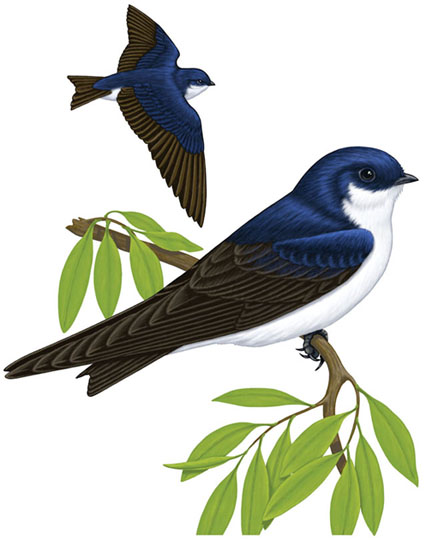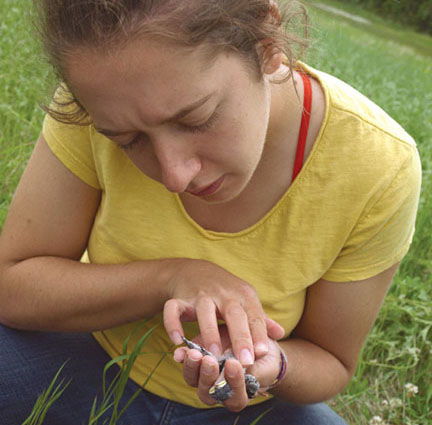A Summer With the Swallows
Tree swallows are not rare birds. In fact, they’re quite common across North America, reaching farther north than any other swallow to nest and breed in Alaska. That’s where two Swarthmore students studied them this summer, performing separate but overlapping research projects near Fairbanks with Assistant Professor of Biology Julie Hagelin.
Hagelin, an expert in avian behavioral ecology, invited Ashley Miniet and Meredyth Duncan to assist her in collecting data on the behavior of the swallow, which finds Alaska a particularly good place to raise its young. “The birds can take advantage of the long days and bug-filled air,” says Hagelin. “The abundance and accessibility of tree swallows in Alaska also make them an ideal species to examine closely.”
Miniet, a senior biology major, worked with the Alaska Bird Observatory (ABO), at Creamer’s Field Migratory Waterfowl Refuge in Fairbanks, on a nest-box monitoring study that has been underway for more than a decade. She also directed the ABO’s summer program for elementary through high-school students, leading the children and teens on data-collecting expeditions, noting the location and orientation of about 100 boxes as well as gathering information on the nests and tree swallow breeding behavior. Later, they reported on such observations, including how many chicks had hatched and whether the chicks had fledged (taken flight out of the nest) successfully. Miniet also taught her junior ornithologists how to measure the tiny chicks and place light-weight identification bands on their legs to allow them to be tracked in summers to come.
The data collected by Miniet and the children contributes to a long-term research project to detect trends in lay and hatch dates and whether more eggs hatch in Alaska’s rising summer temperatures. Her data and those collected during previous years by Daisy Yuhas ’09 “showed a significant trend that’s taken place across the years, where lay date seems to occur earlier and earlier in the season.” says Miniet, whose internship was funded by Howard Hughes Medical Institute.
According to Miniet, the rate at which swallows are beginning to lay earlier in the arctic is about 10 times that of the lower 48 states. Furthermore, birds that nest the earliest tend to result in failed nests. There is some indirect evidence that earlier laying is related to increasing global temperatures. Now the task is to determine why early nests are more likely to be unsuccessful.
“I inputted the data I collected into the computer and refined Daisy’s data, updated her graphs, and added to the paper she’d started. It’s a work in progress,” Miniet says.
Duncan, who had just completed her freshman year, aided Hagelin in her ongoing research into the ability of birds to react to scents and whether they can learn and remember scents. Her work was funded by a summer stipend from Swarthmore’s Natural Science and Engineering Division.
“Olfaction in birds is a sensory modality long overlooked by ornithologists and a subject that is yielding new insights into avian behavior,” Hagelin says.
“Birds like swallows don’t have well-developed olfactory bulbs, so not a lot of research has been done on whether they can and do smell,” Duncan adds.
Using the nest boxes as testing locations, they experimentally created some minty-scented nest boxes by hanging a small test tube of mint-oil inside. This exposed eggs and hatchlings to a known odor. Other nest boxes, such as those nearby at the Alaska Bird Observatory, contained no odors and so were ideal for use as controls.
“When the chicks were about nine days old, we took them out of their nests and held them carefully while puffing different odors [including mint] into their nares (nostrils),” Duncan says. “We wanted to see whether the chicks reacted differently to [odors] at either of the two sites.” The project’s two goals are to show whether: (1) nestlings have the capacity to distinguish between different types of odors, and (2) exposure to odors (like mint) early in development can alter a bird’s reaction later in life. The team already has evidence of the former—despite vanishingly small olfactory anatomy, young swallows reacted differently to different odor types. There is also some evidence of the latter—birds that were exposed to mint odor early in life exhibited different reactions to scents than control birds.
If early odor learning plays a role in young birds, it may be that those returning to breed at their natal site, following a long migratory trip from the southern reaches of the continent, might preferentially prefer to nest in minty-smelling boxes. Such a result would suggest that other “natural” odors that birds are exposed to as young in the nest impact breeding decisions later in life.
Duncan adds, “We are working toward a paper” based on the exciting findings from the summer. But “the return rate for swallows is about only five percent, so… the research might take years and involve many more sites of swallow nesting” to reveal the intriguing details of how early odor learning may impact adult breeding behavior.
 Email This Page
Email This Page

